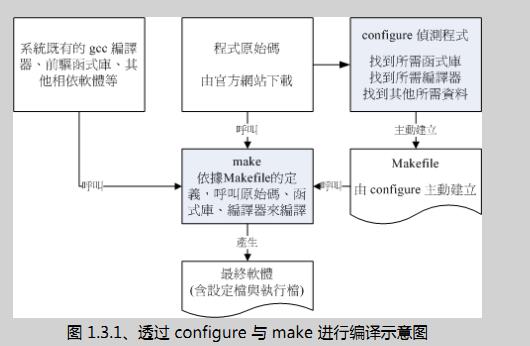用gcc进行程序的编译
Posted tianxintian22
tags:
篇首语:本文由小常识网(cha138.com)小编为大家整理,主要介绍了用gcc进行程序的编译相关的知识,希望对你有一定的参考价值。
在Linux系统上,一个档案能不能被执行看的是有没有可执行的那个权限(x),不过,Linux系统上真正认识的可执行文件其实是二进制文件(binary program),例如/usr/bin/passwd 这些档案就是二进制程序代码。
怎么产生一个可执行的二进制程序呢?首先写程序,用字处理器写完的程序即源代码,这个源代码就是一般的纯文本文档。在完成源代码的编写后,再来就是将程序代码编译成操作系统看得懂的binary program。编译需要编译程序来动作,经过编译程序的编译与连结之后,就可以产生一个可执行的二进制程序。举例来说,Linux上最标准的程序语言是c,我们用c来写源代码,用Linux上标准的c语言编译程序gcc来编译,然后生成可执行的binary program。
有时候我们会在程序中引用其他外部子程序,或者利用其他软件提供的函数功能,我们就必须在编译的过程中,将函式库加进去,这样,编译程序可以将所有的程序代码与函式库作一个连结(Link)以产生正确的执行档(可执行binary program档案)。
- make和configure

- Tarball
Tarball档案,其实就是将软件所有的原始代码档案先以tar打包,然后再以压缩技术来压缩,最常见的是gzip,所以tarball档案的扩展名是*.tar.gz或者*tgz。由于bzip2的压缩效率更佳,因此裆名也会变成*.tar.bz2。
- 打印hello world
(1)直接以gcc编译原始码
[root@localhost]# vi hello.c [root@localhost Documents]# cat hello.c #include <stdio.h> int main(void){ printf("Hello World\\n"); } [root@localhost]# gcc hello.c [root@localhost]# ll total 12 -rwxr-xr-x. 1 root root 4643 Jun 14 00:55 a.out #编译成功的可执行binary program -rw-r--r--. 1 root root 67 Jun 14 00:55 hello.c [root@localhost]# ./a.out #执行文档 Hello World
(2)产生目标文件来进行其他动作,而且执行的档名也不用预设的a.out
[root@localhost]# gcc -c hello.c [root@localhost]# ll hello* -rw-r--r--. 1 root root 67 Jun 14 00:55 hello.c -rw-r--r--. 1 root root 852 Jun 14 01:00 hello.o #产生的目标文件 [root@localhost]# gcc -o hello hello.o [root@localhost]# ll total 16 -rwxr-xr-x. 1 root root 4643 Jun 14 01:00 hello #可执行文件 -rw-r--r--. 1 root root 67 Jun 14 00:55 hello.c -rw-r--r--. 1 root root 852 Jun 14 01:00 hello.o
[root@localhost Documents]# ./hello
Hello World
(3)子程序的编译
[root@localhost]# vi thanks.c [root@localhost]# cat thanks.c #include <stdio.h> int main(void) { printf("Hello World\\n"); thanks_2(); #子程序 } [root@localhost]# vi thanks_2.c [root@localhost]# cat thanks_2.c #include <stdio.h> void thanks_2(void) { printf("Thank you!\\n"); } [root@localhost]# ll thanks* -rw-r--r--. 1 root root 71 Jun 14 01:05 thanks_2.c -rw-r--r--. 1 root root 83 Jun 14 01:03 thanks.c [root@localhost]# gcc -c thanks.c thanks_2.c [root@localhost]# ll thanks* -rw-r--r--. 1 root root 71 Jun 14 01:05 thanks_2.c -rw-r--r--. 1 root root 856 Jun 14 01:05 thanks_2.o -rw-r--r--. 1 root root 83 Jun 14 01:03 thanks.c -rw-r--r--. 1 root root 892 Jun 14 01:05 thanks.o [root@localhost]# gcc -o thanks thanks.o thanks_2.o [root@localhost]# ll thanks* -rwxr-xr-x. 1 root root 4740 Jun 14 01:06 thanks -rw-r--r--. 1 root root 71 Jun 14 01:05 thanks_2.c -rw-r--r--. 1 root root 856 Jun 14 01:05 thanks_2.o -rw-r--r--. 1 root root 83 Jun 14 01:03 thanks.c -rw-r--r--. 1 root root 892 Jun 14 01:05 thanks.o [root@localhost]# ./thanks Hello World Thank you!
(4)此外
[root@localhost]#gcc -O hello.c -c #会自动产生hello.o,并且进行优化 [root@localhost]#gcc -o hello hello.c -Wall #加入-Wall,程序的编译会变的较为严谨,警告信息会显示出来
以上是关于用gcc进行程序的编译的主要内容,如果未能解决你的问题,请参考以下文章